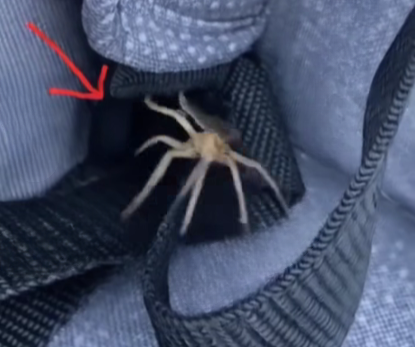It started as an ordinary day. I climbed into my car, buckled my seatbelt, and noticed what looked like a small piece of fuzz stuck in the strap. Harmless, I thought. But then it twitched. That tiny movement quickly turned a normal commute into one of the most unsettling experiences of my life.
What I thought was lint wasn’t lint at all. My car had been invaded by Solifugae—creatures more commonly known as camel spiders, sun spiders, or wind scorpions. While not venomous, these arachnids have a reputation for striking fear into anyone unlucky enough to encounter them.
In this article, we’ll explore:

What Solifugae are and why they strike terror.
How they can find their way into your car.
The dangers they pose (even without venom).
Steps to protect your car and keep them out.
Prevention strategies that actually work.
By the end, you’ll know everything you need to protect yourself from these creepy invaders.
What Exactly Are Solifugae?
Despite their scary nicknames, Solifugae are neither true spiders nor scorpions. They belong to a unique order of arachnids. Found mostly in desert and arid regions, these creatures are adapted for survival in hot, dry climates.
Some quick facts:
Speed demons: They can run up to 10 miles per hour, making them one of the fastest arachnids.
Imposing size: While most species are small, some can grow up to six inches long, including legs.

Powerful jaws: Their massive chelicerae (jaws) can crush and tear prey easily.
No venom: Unlike scorpions or spiders, they don’t inject venom. Their bite, however, can be extremely painful.
Their fearsome look—large, hairy, with oversized mouthparts—often causes panic. Combine that with lightning speed, and it’s easy to see why finding one in your car can trigger instant dread.
The First Encounter in My Car
The first Solifugae I saw was wedged between the seatbelt and the upholstery. It looked like a ball of dust—until it moved. When I pulled back, I saw more skittering in the backseat and even near the door hinges.
What makes them especially terrifying is how well they blend into crevices and shadows. Inside a vehicle, they’re practically invisible until they move. By then, it’s too late—you’ve already sat down next to them.
Why Solifugae in Cars Are a Serious Problem
Even though they aren’t venomous, camel spiders bring a whole set of problems when they get inside a car:
Painful bites
Their jaws can puncture skin, leaving sharp pain, swelling, redness, and sometimes infection.
Stress and distraction
Imagine driving on the highway and seeing a spider-like creature dart across your dashboard. It’s a recipe for panic and accidents.
Health risks
While not venomous, their bites can break skin, and if untreated, may lead to bacterial infection.
Infestation risk
Where there’s one, there may be more. Solifugae seek shelter in groups if they find a suitable spot.
How Do They Get Into Cars?
Solifugae are attracted to dark, hidden spaces. Cars parked in certain environments are prime targets:
Dry, brushy areas: They thrive in deserts, scrublands, and dry fields.
Night warmth: Vehicles retain heat after sunset, making them inviting.
Food crumbs and pests: Leftover food can attract insects—prey for Solifugae. If the bugs go in, the predators follow.
Unsealed gaps: Door gaps, undercarriage openings, or trunk cracks make entry easy.
Signs of Solifugae Infestation in Your Car
If you suspect these creatures might have taken up residence, look for:
Fast-moving shadows when you open the door.
Strange crawling sensations near upholstery.
Exoskeleton remains (shed skins).

Dead insects near floor mats—Solifugae are hunters and leave signs behind.
How Dangerous Are They, Really?
It’s important to separate myth from reality:
MYTH: Camel spiders chase humans to bite them.
FACT: They sometimes appear to chase, but in reality, they’re seeking shade—your shadow.
MYTH: Their bite injects deadly venom.
FACT: They don’t have venom glands. The danger comes from infection.
MYTH: They can jump onto people.
FACT: They can climb, but they don’t leap like some spiders.
In short: they’re more frightening in appearance than truly life-threatening—but still, nobody wants them in their car.
How to Get Rid of Solifugae in Your Car
1. Vacuum Thoroughly
Use a handheld vacuum to reach under seats, between cushions, and around door hinges. This removes both the creatures and the insects they feed on.
2. Seal Entry Points
Inspect your vehicle for cracks around doors, trunk seals, and undercarriage. Replace damaged weather stripping to block entry.
3. Avoid Risky Parking Areas
If you live in or travel through dry, desert-like regions, avoid parking near brush piles, firewood, or open fields.
4. Use Natural Repellents
Solifugae dislike strong scents. Spray diluted peppermint oil or citrus oil around the car’s interior. Not only does it repel them, but it also keeps other pests away.
5. Keep Food Out of the Car
Fast-food bags, crumbs, and spilled drinks attract insects. Those insects, in turn, draw in predators like Solifugae.
6. Professional Pest Control
If the problem persists, consult pest control professionals who specialize in vehicle treatments.
Long-Term Prevention Tips
To keep your car spider-free, adopt these habits:
Weekly cleaning: Regular vacuuming and wiping down surfaces.
Check before trips: Especially if you live in desert states like Arizona, Nevada, or Texas.
Car covers: Use breathable covers when parking outdoors in rural or brush-heavy areas.
Routine inspections: Look under seats, inside glove compartments, and along door linings.
Final Thoughts: Stay Safe, Stay Prepared
Finding Solifugae in your car is terrifying, but with the right prevention and cleaning methods, you can keep these creepy crawlies at bay. They may not be venomous, but their appearance, painful bite, and unsettling speed make them unwelcome passengers.
The best defense is a clean, sealed, and well-maintained vehicle. Pay attention to where you park, keep food out, and use natural repellents.
So the next time you spot something fuzzy on your seatbelt—don’t dismiss it. Look twice. Because sometimes, that little tuft of lint may not be lint at all.



